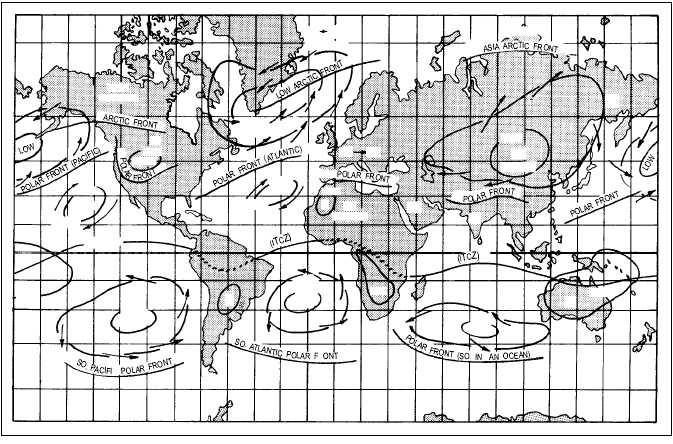coincident with the greatest temperature contrasts. Two
of the most important frontal zones are those over the
north Pacific and north Atlantic Oceans. In winter, the
arctic front, a boundary between polar and arctic air,
forms in high latitudes over northwest North America,
the north Pacific, and near the Arctic Circle north of
Europe (fig. 4-25). In summer, the arctic front mainly
disappears, except north of Europe. (See fig. 4-26.)
The polar front, on the other hand, is present the
year round, although it is not as intense in the summer
as in the winter because of a lessening temperature
contrast between the opposing air masses. The polar
front forms wherever the wind flow and temperature
contrast is favorable. Usually this is the boundary
between tropical and polar air, but it may form between
maritime polar and continental polar air. It also may
exist between modified polar air and a fresh outbreak of
polar air. The polar front is common over North
America in the continental regions in winter in the
vicinity of 50°N latitude.
The polar front in winter is found most frequently
off the eastern coasts of continents in areas of 30° to 60°
latitude. It is also found over land; but since the
temperature contrasts are greater between the continent
and the oceans, especially in winter, the coastal areas
are more favorable for formation and intensification of
the polar front.
The intertropical convergence zone (ITCZ), though
not truly a front but a field of convergence between the
opposing trades, forms a third semipermanent frontal
type. This region shows a seasonal variation just as do
the trade winds.
FRONTAL CHARACTERISTICS
LEARNING OBJECTIVE: Describe the
frontal elements and general characteristics of
fronts.
FRONTAL ELEMENTS
From our previous discussion and definitions of
fronts, it was implied that a certain geometrical and
meteorological consistency must exist between fronts
4-26
cA
SOURCE
MP
1020
1020
HIGH
HIGH
cA
A
M
SOURCE
1000
MP
M
C
P
P
1020
HIGH
MT
CP
(I
C
T Z)
MT
MED
1020
C
SOURCE
T
H
CT
1020
HIGH
L
LOW
1020
HIGH
MT
1010
C
R
MT
1020
HIGH
MT
CT
CT
LOW
C
SOURCE
P
1032
C
SOURCE
A
CA
180
150
120
90
60
30
0
30
60
90
120
150
180
75
60
45
30
15
0
15
30
45
60
75
60
45
30
15
0
15
30
45
60
DI
JANUARY
AG5f0425
Figure 4-25.—Chart showing world air masses, fronts and centers of major pressure systems in January.


